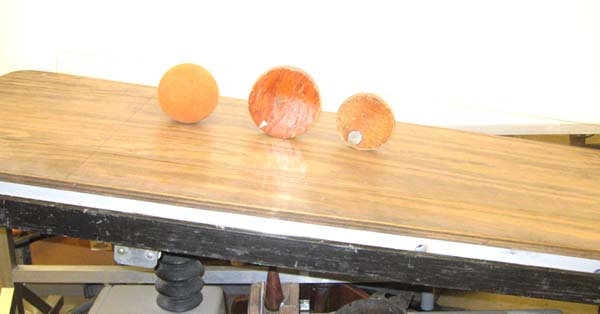Breadcrumb
1K10.50 - Rolling a Disc Uphill

Code Number: 1K10.50
Demo Title: Rolling a Disc Uphill
Condition: Excellent
Principle: Centers of Mass, Torque
Area of Study: Mechanics
Equipment:
Hydraulic Table/Ramp, Disks and Sphere with offset center of mass.
Procedure:
Incline the ramp to the desired angle. Place the disk or sphere on the ramp and turn them so that the mass is toward the top. Let go and they should roll a short way up the ramp.
References:
- Chiu-king Ng, "Resting a Disk on a Rough Incline", TPT, Vol. 60, #4, April 2022, p. 244.
- Roberto De Luca, "Will the Wheel Stand Still Uphill?", TPT, Vol. 59, #6, Sept. 2021, p. 430.
- Rod Cross, "Rolling Uphill", TPT, Vol. 55, April 2017, p. 221.
- R. De Luca, "Oscillation of a Balanced Hollow Cylinder on an Inclined Plane", AJP, Vol. 89, #7, July 2021, p. 677.
- M. F. Maritz, W. F. D. Theron, "Experimental Verification of the Motion of a Loaded Hoop", AJP, Vol. 80, # 7, July 2012, p. 594.
- Andrew Talor, Mary Fehrs, "The Dynamics of an Eccentrically Loaded Hoop", AJP, Vol. 78, # 5, May 2010, p. 496.
- Antonino Carnevali, Russell May, "Rolling Motion of Non-Axisymmetric Cylinders", AJP, Vol. 73, # 10, Oct. 2005, p. 909.
- W. F. D. Theron, "The Rolling Motion of an Eccentrically Loaded Wheel", AJP, Vol. 68, # 9, p. 812, Sept. 2000.
- Robert Ehrlich, "D.7, Weighted Styrofoam Sphere and Disk on An Incline", Turn the World Inside Out, p. 46.
- Janice VanCleave, "85, Uphill Roller", Teaching the Fun of Physics, p. 126.